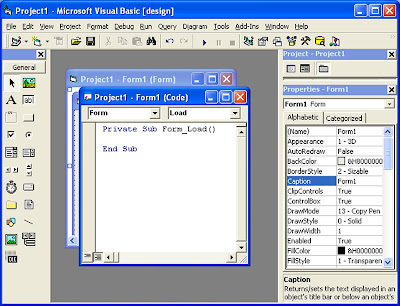In this section, we will not go into the technical aspects of
Visual Basic programming yet, what you need to do is just try out the examples
below to see how does in VB program look like:
Example 2.1.1 is a simple program. First of all, you have to
launch Microsoft Visual Basic 6. Normally, a default form with the name Form1
will be available for you to start your new project. Now, double click on
Form1, the source code window for Form1 as shown in figure 2.1 will appear. The
top of the source code window consists of a list of objects and their
associated events or procedures. In figure 2.1, the object displayed is Form
and the associated procedure is Load.

figure 2.1
When you click on the object box, the drop-down list will display
a list of objects you have inserted into your form as shown in figure 2.2.
Here, you can see a form with the name Form1, a command button with the name
Command1, a Label with the name Label1 and a Picture Box with the name
Picture1. Similarly, when you click on the procedure box, a list of procedures
associated with the object will be displayed as shown in figure 2.3. Some of
the procedures associated with the object Form1 are Activate, Click, DblClick
(which means Double-Click) , Drag Drop, key Press and more. Each object has its
own set of procedures. You can always select an object and write codes for any
of its procedure in order to perform certain tasks.
You do not have to worry about the
beginning and the end statements (i.e. Private Sub Form_Load.......End Sub.); Just key in the lines in between the above two statements
exactly as are shown here. When you press F5to
run the program, you will be surprise that nothing shown up .In order to
display the output of the program, you have to add the Form1.show statement
like in Example 2.1.1 or you can just use Form_Activate ( ) event procedure as shown in example 2.1.2. The command Print does
not mean printing using a printer but it means displaying the output on the
computer screen. Now, press F5 or click on the run button to run the program
and you will get the output as shown in figure 2.4.
In this section, we will not go into the technical aspects of
Visual Basic programming yet, what you need to do is just try out the examples
below to see how does in VB program look like:
Example 2.1.1 is a simple program. First of all, you have to
launch Microsoft Visual Basic 6. Normally, a default form with the name Form1
will be available for you to start your new project. Now, double click on
Form1, the source code window for Form1 as shown in figure 2.1 will appear. The
top of the source code window consists of a list of objects and their
associated events or procedures. In figure 2.1, the object displayed is Form
and the associated procedure is Load.
Example 2.1.1 is a simple program. First of all, you have to
launch Microsoft Visual Basic 6. Normally, a default form with the name Form1
will be available for you to start your new project. Now, double click on
Form1, the source code window for Form1 as shown in figure 2.1 will appear. The
top of the source code window consists of a list of objects and their
associated events or procedures. In figure 2.1, the object displayed is Form
and the associated procedure is Load.
 |
| figure 2.1 |
When you click on the object box, the drop-down list will display
a list of objects you have inserted into your form as shown in figure 2.2.
Here, you can see a form with the name Form1, a command button with the name
Command1, a Label with the name Label1 and a Picture Box with the name
Picture1. Similarly, when you click on the procedure box, a list of procedures
associated with the object will be displayed as shown in figure 2.3. Some of
the procedures associated with the object Form1 are Activate, Click, DblClick
(which means Double-Click) , Drag Drop, key Press and more. Each object has its
own set of procedures. You can always select an object and write codes for any
of its procedure in order to perform certain tasks.
You do not have to worry about the
beginning and the end statements (i.e. Private Sub Form_Load.......End Sub.); Just key in the lines in between the above two statements
exactly as are shown here. When you press F5to
run the program, you will be surprise that nothing shown up .In order to
display the output of the program, you have to add the Form1.show statement
like in Example 2.1.1 or you can just use Form_Activate ( ) event procedure as shown in example 2.1.2. The command Print does
not mean printing using a printer but it means displaying the output on the
computer screen. Now, press F5 or click on the run button to run the program
and you will get the output as shown in figure 2.4.
You can also perform arithmetic calculations as shown in
example 2.1.2. VB uses * to denote the multiplication operator and / to
denote the division operator. The output is shown in figure 2.3, where the
results are arranged vertically.
 |
| Figure 2.2: List of Objects |
 |
| Figure 2.3: List of Procedures |


